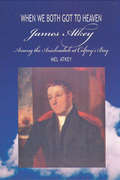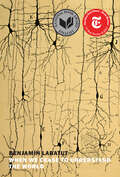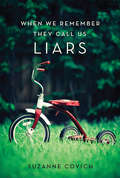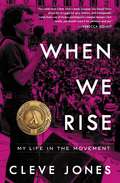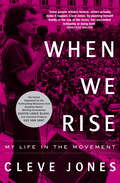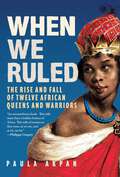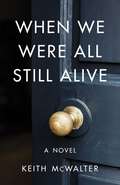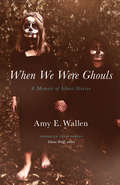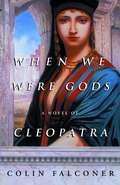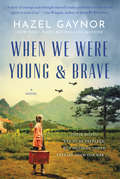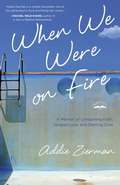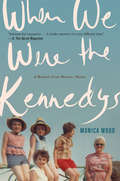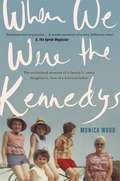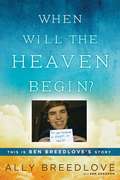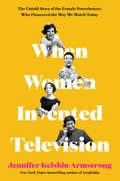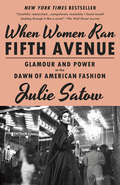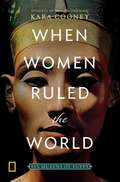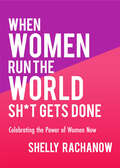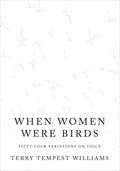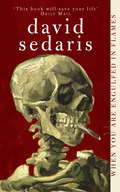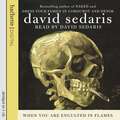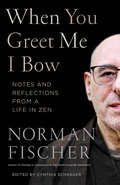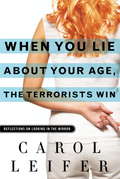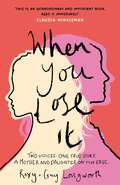- Table View
- List View
When We Both Got to Heaven: James Atkey Among the Anishnabek at Colpoy's Bay
by Mel Atkey Rev Maggie McleodWhen We Both Got to Heaven places James Atkey (1805-1868) on the shores of Georgian Bay at the time of treaty negotiations between the First Nations people of the Saugeen, Nawash and Colpoy’s Bay areas, and the Colonial government. A Methodist lay preacher, Atkey leaves the Isle of Wight and arrives at Colpoy’s Bay with his family in 1855. There he takes up the position of teacher for the Anishnaube children of the area. The great-great-great-grandson of James Atkey, author Mel Atkey engaged in extensive research of both primary and secondary sources. His efforts provide considerable insight into both the influence of Wesleyan Methodism of the time and the background context of the treaty negotiations that ultimately led to the surrender of much of the Saugeen Peninsula for pioneer settlement. People with leadership roles of the past, such as Chief Kegedonce, Kahkewaquonaby (Rev. Peter Jones), Laurence Oliphant and Sir Francis Bond Head, as well as many others, are part of Atkey’s story. Reverend Maggie McLeod of the Cape Croker United Church provides a thoughtful Foreword. This quite remarkable book is a compelling read for those interested in Ontario history, First Nations history, genealogy and the role of religion at the time of European settlement.
When We Cease to Understand the World
by Benjamin LabatutShortlisted for the 2021 International Booker Prize A fictional examination of the lives of real-life scientists and thinkers whose discoveries resulted in moral consequences beyond their imagining.When We Cease to Understand the World is a book about the complicated links between scientific and mathematical discovery, madness, and destruction. Fritz Haber, Alexander Grothendieck, Werner Heisenberg, Erwin Schrödinger—these are some of luminaries into whose troubled lives Benjamín Labatut thrusts the reader, showing us how they grappled with the most profound questions of existence. They have strokes of unparalleled genius, alienate friends and lovers, descend into isolation and insanity. Some of their discoveries reshape human life for the better; others pave the way to chaos and unimaginable suffering. The lines are never clear.At a breakneck pace and with a wealth of disturbing detail, Labatut uses the imaginative resources of fiction to tell the stories of the scientists and mathematicians who expanded our notions of the possible.
When We Remember They Call Us Liars
by Suzanne CovichGrowing up in the 1960s in a small rural community, Suzanne Covich is the kind of girl who won’t cry, who plays dead, and whose vulnerability is disguised beneath Huck Finn bravado. Her father, on the other hand, is the kind of man who will burn down the house and crawl between his daughters’ sheets. Raw and compelling, this is the extraordinary memoir of a violent childhood and the uplifting account of triumph over adversity.
When We Rise: My Life in the Movement
by Cleve JonesThe partial inspiration for the forthcoming ABC television mini-series from Academy Award-winning screenwriter Dustin Lance Black, executive producer Gus Van Sant, and starring Guy Pearce, Mary-Louise Parker, Carrie Preston, and Rachel Griffiths. "You could read Cleve Jones's book because you should know about the struggle for gay, lesbian, and transgender rights from one of its key participants--maybe heroes--but really, you should read it for pleasure and joy."--Rebecca Solnit, author of Men Explain Things to Me Born in 1954, Cleve Jones was among the last generation of gay Americans who grew up wondering if there were others out there like himself. There were. Like thousands of other young people, Jones, nearly penniless, was drawn in the early 1970s to San Francisco, a city electrified by progressive politics and sexual freedom. Jones found community--in the hotel rooms and ramshackle apartments shared by other young adventurers, in the city's bathhouses and gay bars like The Stud, and in the burgeoning gay district, the Castro, where a New York transplant named Harvey Milk set up a camera shop, began shouting through his bullhorn, and soon became the nation's most outspoken gay elected official. With Milk's encouragement, Jones dove into politics and found his calling in "the movement." When Milk was killed by an assassin's bullet in 1978, Jones took up his mentor's progressive mantle--only to see the arrival of AIDS transform his life once again. By turns tender and uproarious--and written entirely in his own words--When We Rise is Jones' account of his remarkable life. He chronicles the heartbreak of losing countless friends to AIDS, which very nearly killed him, too; his co-founding of the San Francisco AIDS Foundation during the terrifying early years of the epidemic; his conception of the AIDS Memorial Quilt, the largest community art project in history; the bewitching story of 1970s San Francisco and the magnetic spell it cast for thousands of young gay people and other misfits; and the harrowing, sexy, and sometimes hilarious stories of Cleve's passionate relationships with friends and lovers during an era defined by both unprecedented freedom and possibility, and prejudice and violence alike. When We Rise is not only the story of a hero to the LQBTQ community, but the vibrantly voice memoir of a full and transformative American life--an activist whose work continues today.
When We Rise: My Life in the Movement
by Cleve JonesThe partial inspiration for the acclaimed mini-series from Academy Award-winning screenwriter Dustin Lance BlackBorn in 1954, Cleve Jones was among the last generation of gay Americans who grew up wondering if there were others out there like himself. There were. Like thousands of other young people, Jones, nearly penniless, was drawn in the early 1970s to San Francisco, a city electrified by progressive politics and sexual freedom. Jones found community - in the hotel rooms and ramshackle apartments shared by other young adventurers, in the city's bathhouses and gay bars like The Stud, and in the burgeoning gay district, the Castro, where a New York transplant named Harvey Milk set up a camera shop, began shouting through his bullhorn, and soon became the nation's most outspoken gay elected official. With Milk's encouragement, Jones dove into politics and found his calling in 'the movement.' When Milk was killed by an assassin's bullet in 1978, Jones took up his mentor's progressive mantle - only to see the arrival of AIDS transform his life once again. By turns tender and uproarious - and written entirely in his own words - When We Rise is Jones' account of his remarkable life. He chronicles the heartbreak of losing countless friends to AIDS, which very nearly killed him, too; his co-founding of the San Francisco AIDS Foundation during the terrifying early years of the epidemic; his conception of the AIDS Memorial Quilt, the largest community art project in history; the bewitching story of 1970s San Francisco and the magnetic spell it cast for thousands of young gay people and other misfits; and the harrowing, sexy, and sometimes hilarious stories of Cleve's passionate relationships with friends and lovers during an era defined by both unprecedented freedom and possibility, and prejudice and violence alike. When We Rise is not only the story of a hero to the LQBTQ community, but the vibrantly voice memoir of a full and transformative American life - an activist whose work continues today.
When We Ruled: The Rise and Fall of Twelve African Queens and Warriors
by Paula AkpanDiscover the reigns of twelve African queens and warriors from across the continent in this immersive and pioneering history.Njinga Mbande. Nana Yaa Asantewaa. Makobo Modjadji VI. Ranavalona the First These queens and warriors ruled vast swathes of the African continent, where they led, loved and fought for their kingdoms and people. Their impact can still be felt today, and yet, beyond the lands they called home, so few of us have ever heard their names. In When We Ruled, historian Paula Akpan takes us into the worlds of these powerful figures, following their stories and how they came to rule and influence the futures of their people. Through deep research and discovery, Akpan will uncover new truths and grapple with uncomfortable realities, allowing us to be immersed in countless moments of bravery, intrigue and, for some, the unravelling of their rule. With reigns spanning from pre-colonial Nigeria to the rich lands of Rwanda, and from Ancient Egypt to apartheid South Africa, these rulers shed a new light on gender politics in these regions, showing how women were celebrated and revered before colonising powers took hold, and continue to be long after. In this game-changing narrative of twelve lives, Akpan takes us on a spellbinding, enrapturing and immersive history that is nothing short of revelatory.
When We Were All Still Alive: A Novel
by Keith McWalterFor Conrad Burrell—husband, father, and successful attorney in the autumn of his life—the world has come apart. Having long ago lost his first wife, the mother of his grown daughter and a widow herself, to youth and pride, he’s now lost his second to a violent accident,. “You think you’re finished, that you have no more stories in you,” his ex-wife warns, and he fears she’s right. Within hailing distance of the end of his days, after a lifetime of meeting the expectations of others, none are left but Conrad’s own, and he must discover whether love survives death as well as divorce—whether family memory can redeem individual mortality. What do we do, then, we widows and widowers for whom there’s nothing left but the world’s permission to stop what we’ve done all our lives? In the cities of his youth, in the deserts of New Mexico, but most of all in a small Pennsylvania town, Conrad finds he has one more lesson in love to learn from the women of his past, and the one woman he's certain he can't live without. When We Were All Still Alive is a novel of grief and healing, a portrait of a marriage, and a love song to ordinary lives.
When We Were Ghouls: A Memoir of Ghost Stories (American Lives)
by Amy E. WallenWhen Amy E. Wallen’s southern, blue-collar, peripatetic family was transferred from Ely, Nevada, to Lagos, Nigeria, she had just turned seven. From Nevada to Nigeria and on to Peru, Bolivia, and Oklahoma, the family wandered the world, living in a state of constant upheaval. When We Were Ghouls follows Wallen’s recollections of her family who, like ghosts, came and went and slipped through her fingers, rendering her memories unclear. Were they a family of grave robbers, as her memory of the pillaging of a pre-Incan grave site indicates? Are they, as the author’s mother posits, “hideous people?” Or is Wallen’s memory out of focus? In this quick-paced and riveting narrative, Wallen exorcizes these haunted memories to clarify the nature of her family and, by extension, her own character. Plumbing the slipperiness of memory and confronting what it means to be a “good” human, When We Were Ghouls links the fear of loss and mortality to childhood ideas of permanence. It is a story about family, surely, but it is also a representation of how a combination of innocence and denial can cause us to neglect our most precious earthly treasures: not just our children but the artifacts of humanity and humanity itself.
When We Were Gods: A Novel of Cleopatra
by Colin FalconerFalconer recreates Cleopatra's life, but, more importantly, turns her into a fierce and vulnerable three-dimensional character of flesh and blood, whose every thought and emotion is vivid and believable.
When We Were Young & Brave: A Novel
by Hazel Gaynor"Gaynor's story of courage and strength will make you believe in the heroic spirit in each of us." —Lisa Wingate, #1 New York Times bestselling author of Before We Were YoursThe New York Times bestselling author of The Girl Who Came Home sets her unforgettable new novel in China during WWII, inspired by true events surrounding the Japanese Army’s internment of teachers and children from a British-run missionary school.Their motto was to be prepared, but nothing could prepare them them for war. China, December 1941. Having left an unhappy life in England for a teaching post at a missionary school in northern China, Elspeth Kent is now anxious to return home to help the war effort. But as she prepares to leave China, a terrible twist of fate determines a different path for Elspeth, and those in her charge. Ten-year-old Nancy Plummer has always felt safe at Chefoo School, protected by her British status. But when Japan declares war on Britain and America, Japanese forces take control of the school and the security and comforts Nancy and her friends are used to are replaced by privation, uncertainty and fear. Now the enemy, and separated from their parents, the children look to their teachers – to Miss Kent and her new Girl Guide patrol especially – to provide a sense of unity and safety. Faced with the relentless challenges of oppression, the school community must rely on their courage, faith and friendships as they pray for liberation – but worse is to come when they are sent to a distant internment camp where even greater uncertainty and danger await . . . Inspired by true events, When We Were Young and Brave is an unforgettable novel about impossible choices and unimaginable hardship, and the life-changing bonds formed between a young girl and her teacher in a remote corner of a terrible war.
When We Were on Fire: A Memoir of Consuming Faith, Tangled Love, and Starting Over
by Addie ZiermanIn the strange, us-versus-them Christian subculture of the 1990s, a person's faith was measured by how many WWJD bracelets she wore and whether he had kissed dating goodbye. Evangelical poster child Addie Zierman wore three bracelets asking what Jesus would do. She also led two Bible studies and listened exclusively to Christian music. She was on fire for God and unaware that the flame was dwindling--until it burned out. Addie chronicles her journey through church culture and first love, and her entrance--unprepared and angry--into marriage. When she drops out of church and very nearly her marriage as well, it is on a sea of tequila and depression. She isn't sure if she'll ever go back. When We Were on Fire is a funny, heartbreaking story of untangling oneself from what is expected to arrive at faith that is not bound by tradition or current church fashion. Addie looks for what lasts when nothing else seems worth keeping. It's a story for doubters, cynics, and anyone who has felt alone in church. returning to love, Jesus, and (perhaps toughest of all) his imperfect followers. And, in the end, it's about what lasts when nothing else seems worth keeping.
When We Were the Kennedys: A Memoir from Mexico, Maine
by Monica WoodWinner of the Sarton Memoir Award. &“[A] marvel of storytelling, layered and rich . . . an account of one family&’s grief, love, and resilience&” (Maine Sunday Telegram). Mexico, Maine, 1963: The Wood family is much like its close, Catholic, immigrant neighbors, all dependent on the fathers&’ wages from the Oxford Paper Company. But when Dad suddenly dies on his way to work, Mum and the four deeply connected Wood girls are set adrift. When We Were the Kennedys is the story of how a family, a town, and then a nation mourns and finds the strength to move on. &“Intimate but expansive . . . A tender memoir of a very different time.&”—O, The Oprah Magazine &“Every few years, a memoir comes along that revitalizes the form . . . With generous, precise, and unsentimental prose, Monica Wood brilliantly achieves this . . . When We Were the Kennedys is a deeply moving gem!&”—Andre Dubus III, #1 New York Times bestselling author &“On her own terms, wry and empathetic, Wood locates the melodies in the aftershock of sudden loss.&”—The Boston Globe &“This is an extraordinarily moving book, so carefully and artfully realized, about loss and life and love. Monica Wood displays all her superb novelistic skills in this breathtaking, evocative new memoir. Wow.&”—Ken Burns, filmmaker &“A gorgeous, gripping memoir. I don&’t know that I&’ve ever pulled so hard for a family. When We Were the Kennedys captures a shimmering mill-town world on the edge of oblivion, in a voice that brims with hope, feeling, and wonder. The book humbles and soars.&”—Mike Paterniti, New York Times bestselling author
When We Were the Kennedys: A moving family memoir of love, loss and strength
by Monica WoodWHEN WE WERE THE KENNEDYS is a brilliant, award-winning memoir about the death of a father and the healing of a family, by Monica Wood, the acclaimed author of THE ONE-IN-A-MILLION BOY. Perfect for those who loved Cathy Rentzenbrink's THE LAST ACT OF LOVE or Helen Macdonald's H IS FOR HAWK. 'It's a pleasure to linger with her elegant prose, keen eye and grace of thought' Reader's Digest 'Intimate but expansive ... A tender memoir of a very different time' O, the Oprah Magazine 1963. The Wood family is much like their neighbours, all dependent on the fathers' wages from the local mill. But when Dad suddenly dies on his way to work one April morning, Mum and the four deeply connected Wood daughters are set adrift.And then, come November - the family still overwhelmed by grief, the country shocked by the assassination of President Kennedy - Mum announces an unprecedented family road trip. Inspired by the televised grace of Jackie Kennedy, herself a new widow with young children, Mum and her girls head to Washington, DC, to do some rescuing of their own. WHEN WE WERE THE KENNEDYS is a funny, moving and imaginative memoir about how one family and one country, each shocked by the unimaginable, find the strength to move on.What readers are saying about WHEN WE WERE THE KENNEDYS: 'A beautifully written, thought-provoking book''Filled with great love - of family, friends and the ability to bounce back even with many setbacks. Wood's words are so beautiful they literally lift off the pages''Compelling, profound, beautiful'
When Will the Heaven Begin?
by Ken Abraham Ally BreedloveAN INSPIRATIONAL AND HEARTRENDING MEMOIR ABOUT BEN BREEDLOVE, WHO SHARED HIS NEAR-DEATHEXPERIENCES AND VISIONS OF HEAVEN IN HIS VIRAL VIDEOS--WRITTEN BY HIS SISTER, ALLY BREEDLOVE.<P>P>On Christmas Day 2011, Ben Breedlove's soul went to heaven. But it wasn't his first time there. Ben suffered from hypertrophic cardiomyopathy (HCM), a heart condition that posed a constant risk of sudden death. His condition, a thickening of the heart muscle, worsened over time, leaving him weak and fatigued. It also led Ben to some close calls medically, in particular cardiac arrest on four separate occasions, during which he felt the presence of angels and experienced the perfect peace of heaven.<P>Precocious and warm, Ben was close with his family and two siblings, and forged deep relationships with his friends. He loved to wakeboard and wake surf, and he had dreams of visiting foreign countries around the world. He created the YouTube channels TotalRandomness512 and BreedloveTV, and co-created the channel OurAdvice4You, where he posted videos about everything from dating advice for girls to more serious topics like his spirituality and heart condition.Unbeknownst to his parents and family, Ben created a two-part video called "This Is My Story," in which he used flashcards to tell the world about his near-death experiences and his beckoning toward heaven.When he died a short while later, at the tender age of eighteen, his family and the rest of the world stumbled upon these videos. <P>The world responded with overwhelming acceptance of the message Ben shared.Sharing his vision of heaven was Ben's gift to his family, and to the world. And now this is the Breedlove family's gift to us - an in-depth look at the life and near-deaths of Ben, the strength and faith of a family, and ultimately, the hope of heaven.Do you believe in Angels or God? I Do. - Ben Breedlove
When Women Invented Television: The Untold Story of the Female Powerhouses Who Pioneered the Way We Watch Today
by Jennifer Keishin ArmstrongNew and Noteworthy —New York Times Book ReviewMust-Read Book of March —Entertainment WeeklyBest Books of March —HelloGiggles&“Leaps at the throat of television history and takes down the patriarchy with its fervent, inspired prose. When Women Invented Television offers proof that what we watch is a reflection of who we are as a people.&” —Nathalia Holt, New York Times–bestselling author of Rise of the Rocket GirlsNew York Times–bestselling author of Seinfeldia Jennifer Keishin Armstrong tells the little-known story of four trailblazing women in the early days of television who laid the foundation of the industry we know today. It was the Golden Age of Radio and powerful men were making millions in advertising dollars reaching thousands of listeners every day. When television arrived, few radio moguls were interested in the upstart industry and its tiny production budgets, and expensive television sets were out of reach for most families. But four women—each an independent visionary—saw an opportunity and carved their own paths, and in so doing invented the way we watch tv today. Irna Phillips turned real-life tragedy into daytime serials featuring female dominated casts. Gertrude Berg turned her radio show into a Jewish family comedy that spawned a play, a musical, an advice column, a line of house dresses, and other products. Hazel Scott, already a renowned musician, was the first African American to host a national evening variety program. Betty White became a daytime talk show fan favorite and one of the first women to produce, write, and star in her own show. Together, their stories chronicle a forgotten chapter in the history of television and popular culture. But as the medium became more popular—and lucrative—in the wake of World War II, the House Un-American Activities Committee arose to threaten entertainers, blacklisting many as communist sympathizers. As politics, sexism, racism, anti-Semitism, and money collided, the women who invented television found themselves fighting from the margins, as men took control. But these women were true survivors who never gave up—and thus their legacies remain with us in our television-dominated era. It's time we reclaimed their forgotten histories and the work they did to pioneer the medium that now rules our lives. This amazing and heartbreaking history, illustrated with photos, tells it all for the first time.
When Women Ran Fifth Avenue: Glamour and Power at the Dawn of American Fashion
by Julie SatowNEW YORK TIMES BESTSELLER • A glittering portrait of the golden age of American department stores and of three visionary women who led them, from the award-winning author of The Plaza.A BEST BOOK OF THE YEAR: Vogue, Smithsonian, New York Post, and Financial Times"Ms. Satow&’s carefully researched book is compulsively readable: I found myself dashing through it like a novel. She portrays the women with verve; we get a glimpse into their lives, as well as a sense of what it was like at each of these retail meccas." —The Wall Street JournalThe twentieth century American department store: a palace of consumption where every wish could be met under one roof – afternoon tea, a stroll through the latest fashions, a wedding (or funeral) planned. It was a place where women, shopper and shopgirl alike, could stake out a newfound independence. Whether in New York or Chicago or on Main Street, USA, men owned the buildings, but inside, women ruled.In this hothouse atmosphere, three women rose to the top. In the 1930s, Hortense Odlum of Bonwit Teller came to her husband's department store as a housewife tasked with attracting more shoppers like herself, and wound up running the company. Dorothy Shaver of Lord & Taylor championed American designers during World War II--before which US fashions were almost exclusively Parisian copies--becoming the first businesswoman to earn a $1 million salary. And in the 1960s Geraldine Stutz of Henri Bendel re-invented the look of the modern department store. With a preternatural sense for trends, she inspired a devoted following of ultra-chic shoppers as well as decades of copycats.In When Women Ran Fifth Avenue, journalist Julie Satow draws back the curtain on three visionaries who took great risks, forging new paths for the women who followed in their footsteps. This stylish account, rich with personal drama and trade secrets, captures the department store in all its glitz, decadence, and fun, and showcases the women who made that beautifully curated world go round.
When Women Ruled the World: Six Queens of Egypt
by Kara CooneyThis riveting narrative explores the lives of six remarkable female pharaohs, from Hatshepsut to Cleopatra - women who ruled with real power - and shines a piercing light on our own perceptions of women in power today. <P><P>Female rulers are a rare phenomenon - but thousands of years ago in ancient Egypt, women reigned supreme. Regularly, repeatedly, and with impunity, queens like Hatshepsut, Nefertiti, and Cleopatra controlled the totalitarian state as power brokers and rulers. But throughout human history, women in positions of power were more often used as political pawns in a male-dominated society. <P><P>What was so special about ancient Egypt that provided women this kind of access to the highest political office? What was it about these women that allowed them to transcend patriarchal obstacles? What did Egypt gain from its liberal reliance on female leadership, and could today's world learn from its example? <P><P>Celebrated Egyptologist Kara Cooney delivers a fascinating tale of female power, exploring the reasons why it has seldom been allowed through the ages and why we should care.
When Women Run the World Sh*t Gets Done: Celebrating the Power of Women Now
by Shelly Rachanow“This is a book about the power women have—and are using to help heal the broken bones of this beautiful world.” —Sherry Richert Belul, author of Say it NowPacked with stories of ordinary women doing extraordinary things, this book is a must-have for any woman who has ever dreamt of a better world. Dive into this empowering narrative and read about:A trauma surgeon working to stem the epidemic of gun violenceA professor who ran for office to provide a better role model for her sonsAn educator raising India’s poorest girls out of povertyTeens fighting for clean water, inspiring future generations to continue their workA group of firefighters training to trek across Antarctica, raising awareness for mental health and showing young girls that they are strong and can be anything they chooseActivists from around the world fighting the injustices of inequality and patriarchyOne small action can inspire a movement. And as these women have shown, a movement can change minds . . . and ultimately the world.
When Women Were Birds: Fifty-four Variations on Voice
by Terry Tempest WilliamsIn 54 chapters that unfold like a series of yoga poses, each with its own logic and beauty, Williams creates a lyrical and caring meditation of the mystery of her mother's journals in a book that keeps turning around the question, "What does it mean to have a voice?"
When You Are Engulfed In Flames
by David SedarisDavid Sedaris's remarkable ability to uncover the hilarious absurdity teeming just below the surface of everyday life is elevated to wilder and more entertaining heights than ever in this new book of stories.Sedaris proceeds from bizarre conundrums of daily life - the etiquette of having a lozenge fall from your mouth into the lap of a fellow passenger or how to soundproof your windows with LP covers against neurotic songbirds - to the most deeply resonant human truths. Taking in the parasitic worm that once lived in his mother-in-law's leg, an encounter with a dingo and the purchase of a human skeleton, and culminating in a brilliant account of his attempt to quit smoking - in Tokyo - David Sedaris's sixth story collection is a fresh masterpiece of comic writing.
When You Are Engulfed In Flames
by David SedarisDavid Sedaris's remarkable ability to uncover the hilarious absurdity teeming just below the surface of everyday life is elevated to wilder and more entertaining heights than ever in this new book of stories.Sedaris proceeds from bizarre conundrums of daily life - the etiquette of having a lozenge fall from your mouth into the lap of a fellow passenger or how to soundproof your windows with LP covers against neurotic songbirds - to the most deeply resonant human truths. Taking in the parasitic worm that once lived in his mother-in-law's leg, an encounter with a dingo and the purchase of a human skeleton, and culminating in a brilliant account of his attempt to quit smoking - in Tokyo - David Sedaris's sixth story collection is a fresh masterpiece of comic writing.
When You Greet Me I Bow: Notes and Reflections from a Life in Zen
by Norman FischerFrom beloved Zen teacher Norman Fischer, a collection of essays spanning a life of inquiry into Zen practice, relationship, social engagement, and spiritual creativity. "Looking backwards at a life lived, walking forward into more life to live built on all that, trying not to be too much influenced by what's already been said and done, not to be held to a point of view or an identity previously expressed, trying to be surprised and undone and maybe even dismayed by what lies ahead."--Norman FischerNorman Fischer is a Zen priest, poet, and translator whose writings, teachings, and commitment to interfaith dialogue have supported and inspired Buddhist, Jewish, and other spiritual practitioners for decades. When You Greet Me I Bow spans the entirety of Norman Fischer's career and is the first collection of his writings on Buddhist philosophy and practice. Broken into four sections--the joy and catastrophe of relationship; thinking, writing, and emptiness; cultural encounters; and social engagement--this book allows us to see the fascinating development of the mind and interests of a gifted writer and profoundly committed practitioner.
When You Lie About Your Age, the Terrorists Win: Reflections on Looking in the Mirror
by Carol LeiferStand-up comic and comedy writer Carol Leifer faced a critical dilemma and had only two options: either continue sharing her greatest childhood memory (seeing the Beatles at Shea Stadium in 1966) or lie about her age. But the choice soon became clear: "I see now that when you deny your age, you deny yourself, and when you lie about your age, you become your inauthentic twin. But most important, when you lie about your age, they win. (And of course by 'they,' I mean the terrorists)." Now, in this uproarious book, Leifer reveals all--her age, her outlook, her life philosophy--no holds barred.
When You Lose It: Two voices. One true story. A mother and daughter on the edge. 'A very important subject' – ITV's This Morning
by Gay Longworth Roxy Longworth'Read this book. Then talk to your sons. It is essential reading' Jamie Theakston 'An extraordinary and important book. Read it immediately' Claudia Winkleman 'Superbly written, this deeply moving book underlines how truly precious mother-daughter relationships are, and never more so than in those teenage years' Gloria Hunniford A gripping memoir of two battling narratives and a mother-daughter relationship stretched to its absolute limits.Roxy was 13 years old when she was coerced then blackmailed into sending explicit photos, which were spread around her school. The shame led to self-loathing. The blame led to a psychotic breakdown. Roxy started hearing voices. Then she started seeing things...What happens when your teenager starts to lose it, and then you lose each other? What happens when you can't tell your mother you desperately need help? And how can a family move past a devastating mental health crisis?When You Lose It is a brutally honest true story, written from two perspectives, of consent, coercion and shattering consequences.
When You Lose It: Two voices. One true story. A mother and daughter on the edge. 'A very important subject' – ITV's This Morning
by Gay Longworth Roxy Longworth'Read this book. Then talk to your sons. It is essential reading' Jamie Theakston 'An extraordinary and important book. Read it immediately' Claudia Winkleman 'Superbly written, this deeply moving book underlines how truly precious mother-daughter relationships are, and never more so than in those teenage years' Gloria Hunniford A gripping memoir of two battling narratives and a mother-daughter relationship stretched to its absolute limits.Roxy was 13 years old when she was coerced then blackmailed into sending explicit photos, which were spread around her school. The shame led to self-loathing. The blame led to a psychotic breakdown. Roxy started hearing voices. Then she started seeing things...What happens when your teenager starts to lose it, and then you lose each other? What happens when you can't tell your mother you desperately need help? And how can a family move past a devastating mental health crisis?When You Lose It is a brutally honest true story, written from two perspectives, of consent, coercion and shattering consequences.
